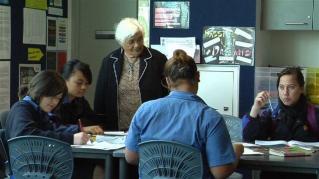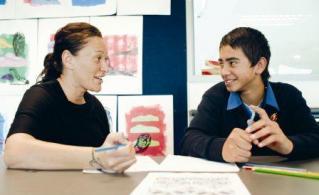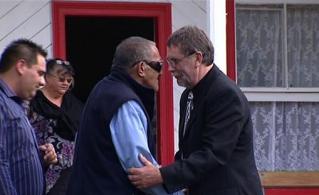Section navigation
At Hillmorton High School, we see the beginnings of a successful push by Te Kauhua facilitators to engage whānau, by organising whānau hui, where data on Māori students’ attendance and achievement was shared.
There is a strong focus at Hillmorton on the ethic of ‘care’; that is, teachers caring for students (their potential and their learning), and students caring for each other.
Faced with compelling data of Māori student underachievement, the teachers embarked on a school-wide action research/ inquiry programme, with each teacher examining an issue that was important to them. As a result of the teachers’ dedication to action research, they became more reflective and empowered to lead their own professional development. Moreover, their focus shifted away from their ‘subject’ to focusing on the young people themselves.
In addition, the school restructured itself into whānau houses and tutor groups. This vertical formation, which brought tuākana and teina together in the same grouping, allowed senior students to step up and take on a leadership role. It also provided potentially at-risk students with a ‘significant other’ in their life.
Questions / Things to think about / Activities
1. The literal meaning of ‘Ka Hikitia’ is to step up, lift up, or lengthen one’s stride. How are we stepping up our performance, to ensure that Māori students are enjoying education success, as Māori? How do we judge Māori student engagement? What does our data-gathering tell us about the achievement of Māori students in our class/school?
2. Using an inquiry process, let's examine our existing beliefs about Māori students and their potential. How do these compare with the beliefs and understandings set out in the various initiatives that have been developed to address the issue of differential achievement (as outlined on this website, Te Mangōroa)? What beliefs do we need to reconsider and reposition? What actions do we need to take to reposition our beliefs?
3. What steps do we need to take to be effective in our action research/inquiry? For example, we could try the following:
i) Select an inquiry theme; that is, one that has relevance to our context.
ii) Construct some questions to investigate, such as:
- How do we know there's an issue?
- What are the needs of our Māori students?
- How can we verify this, for example, through student feedback; observation; or data analysis?
- What is our data on Māori student achievement telling us?
- As teachers, what needs to change in our practice to bring about more effective learning?
- What evidence is there to convince/encourage us to change?
iii) Set challenging goals, and processes for the monitoring thereof.
iv) Take action to achieve our goals. This could include background reading; observation; whānau/student interviews; mentoring/coaching; and searching this website, Te Mangōroa, to see what other schools are doing.
v) Monitor the impact of changes on our students’ learning and their achievement.
vi) Evaluate the changes and identify the next teaching steps.
4. What are some of the benefits of being able to have professional learning conversations? These could include raising our awareness in terms of our thinking, our practice and our feelings of efficacy; providing more student-driven opportunities for them to have input into their learning; increasing student satisfaction; enhancing teacher-student relationships; removing feelings of professional isolation; and increasing job satisfaction.
5. How can we demonstrate increased agency/efficacy in terms of Māori students, such that we take professional responsibility and believe we can bring about change?
6. To involve students in our professional learning and development, let’s design a survey form for Māori students to find out:
- any perceived/real barriers to learning
- any enablers; that is, things that help them learn.
Filed under: Productive partnerships | Effective teachers





